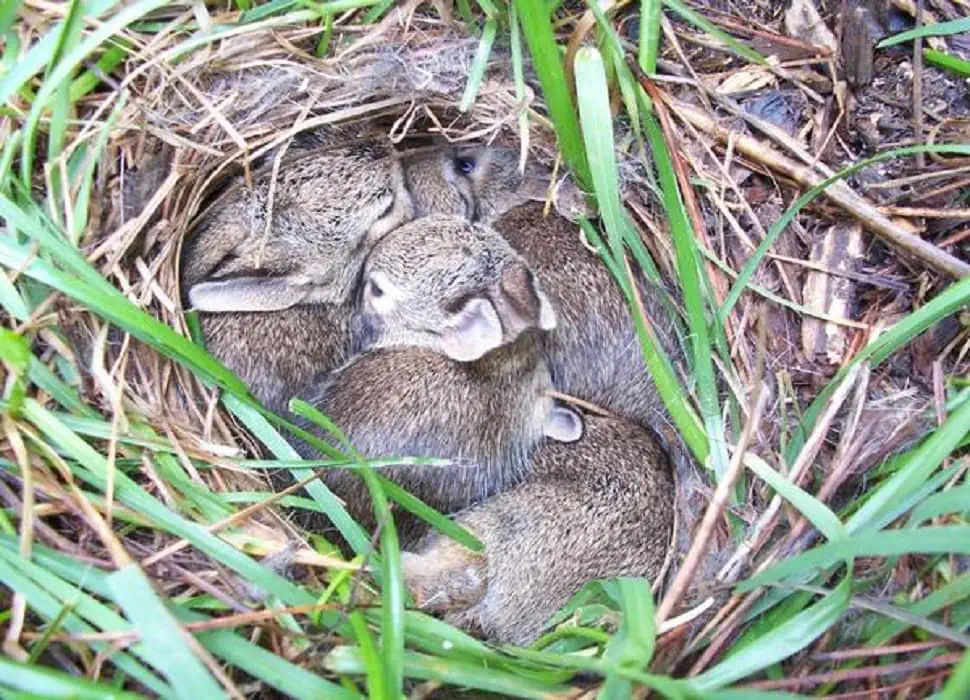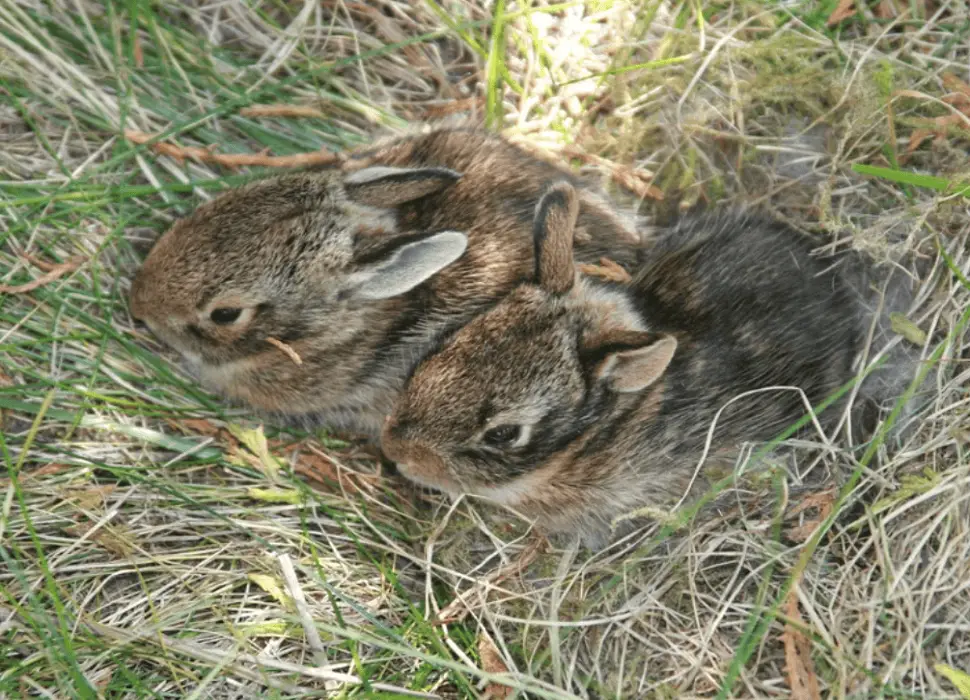During a leisurely stroll in your garden, you unexpectedly stumble upon a quiet corner teeming with life—a nest of baby rabbits nestled amidst the greenery. Their tiny, innocent presence immediately captures your interest, sparking curiosity and a desire to understand their lives. An essential question forms in your mind, when exactly do these tiny babies begin their adventure, venturing out of the safe haven of their nest into the expansive world around them?
Baby rabbits, also known as kits, generally start venturing out of their nest when they are about 2 to 3 weeks old. However, they may not fully leave their nest until they’re around 4 to 5 weeks old.
Introduction
This is an important aspect of rabbit development, not just for the wild cottontail rabbits you may spot in your backyard but also for pet rabbit breeders and owners.

The transition period when the kits start leaving the nest is crucial as it sets the foundation for their independence. In this blog post, we will dive deep into the world of baby rabbits.
We will discuss their lifecycle, explore the factors that determine when they leave the nest, and uncover what happens once they start venturing out.
For rabbit parents, we have some tips on how to care for these tiny creatures during this transition. And for those who stumble upon a nest in the wild, we’ll guide you on the best course of action.
Let’s uncover the fascinating journey of these tiny creatures as they step out into the world.
Understanding the Rabbit Life Cycle
The Rabbit Breeding Process
Rabbits are fascinating creatures with a unique life cycle. Notoriously known for their prolific breeding, rabbits can have multiple litters in a year.
In fact, a female rabbit called a doe, can become pregnant within hours after giving birth. The gestation period for rabbits is typically around 28 to 31 days.
It’s a brief period, but a lot happens during this time as the tiny kits prepare to come into the world.
After a successful mating, the doe prepares a nest for her offspring. The nest is usually a shallow hole lined with fur from the doe herself, creating a soft, warm environment for the babies.

The doe can deliver between one to fourteen kits in a litter, although the average number is usually between four to six.
Baby Rabbits in the Nest
When the baby rabbits are born, they are entirely helpless. They are born hairless, blind, and totally dependent on their mother for warmth and nutrition.
This is when the nest becomes their safe haven. During the first few days, the doe feeds the kits only once or twice a day, spending the rest of the time away from the nest to avoid attracting predators.
Around ten days after birth, significant changes start to occur. The baby rabbits’ eyes and ears open, they begin to grow fur, and they gradually become more active.

Even though they start to explore their surroundings, they are not yet ready to venture out of the nest. They still rely heavily on their mother’s milk for nutrition and antibodies.
Duration in the Nest
The length of time baby rabbits stay in the nest can vary. Several factors can influence this, such as species, weather conditions, availability of food, and threat levels from predators.
However, in most cases, baby rabbits start to leave their nest when they are around two to three weeks old. They start to nibble on hay and pellets, although their primary source of nutrition remains their mother’s milk until they are weaned off around four to five weeks.
At this point, the kits are well on their way to becoming independent rabbits. They will soon begin to fully leave the nest and start their adventures in the bigger world.
This transition is a critical time in their lives and requires a delicate balance of curiosity and caution. So, what happens after they step out of their warm, cozy nest?
When do Baby Rabbits Leave the Nest?
The Age of Exploration
As we’ve established, baby rabbits begin their transition from nest dwellers to explorers when they are around two to three weeks old.
But what does this transition really look like? Around this time, the kits’ curiosity often gets the better of them. Their newfound senses are opening a whole new world of smells, sounds, and textures.
They begin to poke their noses out of the nest, tentatively sniffing the world around them.
As they grow more confident, these little adventurers start to venture a bit further from their nest. However, they don’t stray far or for long.
They might take a few hops around, explore their immediate surroundings, and scurry back to the safety of their nest. It’s a critical time in their development, as they learn to navigate the world around them.
Signs That Kits Are Ready to Leave
As a keen observer, you might be wondering, what are the signs that kits are ready to leave the nest? Well, there are several indicators to look out for.
As mentioned earlier, you might spot the kits poking their heads out of the nest, looking curious and alert. They start to nibble on solid food and drink water, indicating they are ready to supplement their diet beyond their mother’s milk.
Their physical development is another clear indicator. By this time, the kits will have a full coat of fur, their eyes and ears will be open, and they’ll be hopping around confidently.
They start grooming themselves and their littermates, a behavior that’s vital for their social development and hygiene.
Dispelling Misconceptions
There’s a common misconception that baby rabbits are immediately abandoned by their mothers once they leave the nest. However, this isn’t accurate.
Even when they start exploring the world outside their nest, their mother continues to look after them, feeding and grooming them until they are fully weaned.
The weaning process usually takes place when the kits are around four to five weeks old.
In reality, the leaving of the nest is more gradual than abrupt. It’s a phased process where the kits slowly gain their independence while still being under their mother’s watchful eyes.
What Happens After Baby Rabbits Leave the Nest?
Adventures in the Great Beyond
Once the baby rabbits begin to venture out of the nest, they embark on a journey of discovery and learning. Exploring their surroundings is an exciting process, albeit full of risks.
Every scent, sound, and movement is a lesson for them. They nibble on different types of food, learn to recognize potential threats and start mastering the art of foraging.

However, the world outside the nest can be a dangerous place for these tiny explorers. They face potential threats from predators, including birds of prey, snakes, and larger mammals.
Despite these risks, the kits learn to navigate their surroundings, relying on their instincts and the teachings of their mother.
The Survival Tactics of Baby Rabbits
Survival in the wild requires a combination of instinct, learning, and a fair share of luck. The baby rabbits, though vulnerable, are not defenseless.
They learn to rely on their keen senses of smell and hearing to detect danger. They also have a natural camouflage – their fur – which blends into the natural environment, providing an essential line of defense against predators.
In response to potential threats, baby rabbits exhibit ‘freezing’ behavior, a survival tactic where they remain completely still to avoid detection.
They are also swift runners and can execute sudden changes in direction to evade predators. These survival skills develop gradually as they spend more time outside the nest and encounter different situations.
Beyond Survival: Socializing and Developing
While survival is paramount, the life of baby rabbits isn’t all about dodging danger. This phase of their life is also about socializing and developing physically.
They interact with their littermates, engage in playful behaviors, and learn to communicate through a variety of thumps, purrs, and nudges.
They also start to develop their grooming habits, an essential part of rabbit behavior that helps maintain their fur and strengthens social bonds.
This balance of exploration, learning, socializing, and growing is what shapes these baby rabbits into healthy, mature adults.
The transition from a nest-bound kit to an independent rabbit is truly a journey worth understanding. But what about when these rabbits are pets? How should rabbit owners navigate this phase?
How to Care for Baby Rabbits Leaving the Nest (For Pet Owners)
Understanding Their Needs
When you’re caring for baby rabbits who are ready to leave their nest, understanding their needs is crucial.
Rabbits are unique creatures with specific requirements that differ from other common pets.
For example, they have a specialized diet mainly composed of hay, a small number of pellets, fresh water, and a variety of vegetables as they grow older.
They also need exercise and mental stimulation, which they usually get through exploring their environment and playing with their littermates.
As a pet owner, your role is to provide a safe, engaging environment for them to do so. That might involve rabbit-proofing your home, providing toys for them to play with, and ensuring they have plenty of room to hop around.
Providing a Safe Environment
Safety is paramount when it comes to baby rabbits leaving the nest. Rabbit-proofing your home involves ensuring they can’t access electrical wires, toxic plants, and small spaces where they might get stuck.
It’s essential to supervise their explorations, especially in the beginning. This ensures they don’t end up in risky situations.
Rabbits are naturally curious creatures and will investigate anything new in their environment. So, any changes to their space should be carried out with care, keeping their safety in mind.
When they’re not exploring, ensure they have a cozy, quiet place to retreat to. This can be a small cage or a designated corner in your home, lined with comfortable bedding.
Transitioning Their Diet
One of the biggest changes that occur when baby rabbits leave the nest is in their diet. As mentioned earlier, kits begin to nibble on hay and pellets when they’re ready to leave the nest.
However, their digestive systems are still sensitive, and any dietary changes should be gradual.
Start by providing small amounts of alfalfa hay and pellets, which are higher in protein and calories to support their growth.
As they get older, you can slowly introduce a variety of leafy greens. Remember, any new foods should be introduced one at a time and in small amounts to avoid upsetting their stomachs.
Transitioning a baby rabbit from its nest to independence can be a rewarding experience. With careful attention to their diet, environment, and overall needs, you can ensure a healthy and happy bunny.
But what if you discover a nest of wild baby rabbits in your yard? What’s the best course of action?
What to Do if You Find a Nest of Baby Rabbits in the Wild?
The Importance of Non-Interference
If you happen upon a nest of baby rabbits in the wild, the first rule is simple: don’t disturb them. It’s a common misconception that a nest left unattended by the mother means the kits have been abandoned.
However, in reality, mother rabbits leave their offspring alone during the day to avoid attracting predators to the nest.
Unless the baby rabbits appear injured or in distress, the best course of action is non-interference. Resist the urge to handle the kits or move the nest.
Your presence can stress the baby rabbits and may deter the mother rabbit from returning to care for her offspring.
Intervention: When and How?
There might be times when intervention is necessary, such as when the kits are injured, the mother is confirmed dead, or the nest is in imminent danger.
In such cases, contact your local wildlife rehabilitation center for advice. It’s important to remember that wild rabbits are different from domestic breeds and have specific needs that are best handled by professionals.

If immediate action is needed and you can’t get hold of a wildlife expert, ensure you handle the kits with gloved hands to prevent the transfer of human scent.
Injured baby rabbits should be placed in a soft, warm box until help arrives. Do not attempt to feed or give water to the kits, as their dietary requirements are specific and incorrect feeding could cause harm.
Engaging with the Wild Responsibly
Discovering a nest of wild baby rabbits can be a fascinating experience. However, respect for their natural life cycle and the laws of nature is essential.
Try to view this as an opportunity to observe and appreciate wildlife rather than a chance to intervene. Teach children to observe from a distance and to understand the importance of not disturbing these tiny creatures.
Remember, when it comes to baby rabbits leaving the nest, whether in your garden or as pets at home, patience, respect for their developmental process, and awareness of their needs are crucial.
Conclusion
The journey of baby rabbits from birth to becoming independent explorers is truly a marvel of nature. It’s a process characterized by growth, learning, and instinct, providing an enriching glimpse into the world of these intriguing creatures.
As observers or caretakers, our role is to respect this natural process, whether that’s by providing a safe home for our pet bunnies, or by stepping back and allowing mother nature to take its course in the wild.
With understanding and empathy, we can ensure a healthier and happier life for these tiny creatures.
Frequently Asked Questions
How long do baby rabbits stay in the nest?
Baby rabbits typically stay in the nest for about two to three weeks. By the third week, they’re often ready to start venturing out and exploring their surroundings.
Is it safe to touch a wild rabbit’s nest?
While it may be tempting, it’s best not to touch a wild rabbit’s nest. Disturbance could cause the mother to abandon the nest.
What do baby rabbits eat when they leave the nest?
Once baby rabbits leave the nest, they gradually transition to a diet of alfalfa hay and pellets. Over time, leafy greens can be introduced.
How can I rabbit-proof my home for baby rabbits?
Rabbit-proofing your home involves covering electrical wires, removing toxic plants, and ensuring there are no small spaces where the rabbit could get stuck.
What should I do if I find an injured baby rabbit in the wild?
If you find an injured baby rabbit, contact a local wildlife rehabilitation center. While waiting for assistance, keep the rabbit in a warm, soft box but avoid feeding it.
